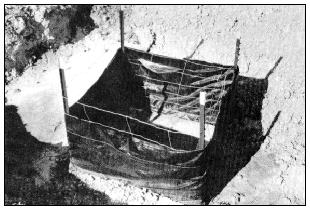
|

|
To Print Use The pdf File
ILLINOIS URBAN MANUAL
PRACTICE STANDARD
INLET PROTECTION - FABRIC DROP
(no.)
CODE 860
 (Source: NC Erosion and Sediment Control Field Manual) |
DEFINITION
A temporary fabric barrier placed around a drop inlet.
PURPOSE
The purpose of this practice is to help prevent sediment from entering storm drains during construction operations. This practice allows early use of the storm drainage system.
CONDITIONS WHERE PRACTICE APPLIES
A fabric drop type of inlet protection may be used where storm drain inlets are to be made operational before permanent stabilization of the disturbed drainage area. This method of inlet protection is effective where the inlet drains a small, nearly level area with slopes generally less than 5% and where shallow sheet flows not exceeding 1 cfs are expected. The immediate land area around the inlet should be relatively flat (less than 1% slope) and located so that accumulated sediment can be easily removed. This method should not be used in areas receiving concentrated flows, such as in street or highway medians.
CRITERIA
The maximum drainage area shall not exceed 1 acre per inlet.
The maximum height of fabric above the crest of the drop inlet shall be 1.5 feet. This height allows a shallow temporary de-silting pool to form behind the fabric but limits the pressure against the fabric if overtopping occurs. The selected height of the top of the barrier should allow overflow to the drop inlet and not let overflow bypass the inlet to unprotected lower areas. It may be necessary to build a temporary dike on the downslope side of the structure to prevent bypass flows.
For fabric barriers, use stakes of 2 x 4-inch wood (preferred) or equivalent metal with a minimum length of 3 feet. Space the stakes a maximum of 3 feet apart, and securely drive them into the ground to a depth of approximately 18 inches.
Drive the stakes close to the drop inlet so that overflow will fall directly into the structure and not on unprotected soil.
To provide needed stability to the installation, make a frame around the stakes a maximum of 1.5 ft above the top of the drop inlet. This will serve as a stable crest for overflow during rainfall. Place the bottom 12 inches of the fabric in a trench and backfill the trench with 12 inches of compacted soil or six inches of crushed gravel.
Fasten fabric securely by staples or wire to the stakes and frames. Joints must be overlapped to the next stake.
Improved performance and sediment storage volume can be obtained by excavating the area. See practice standard, INLET PROTECTION - EXCAVATED DRAIN 855. The fabric shall meet the requirements as shown in Material Specification 592 GEOTEXTILE Table 1 or 2, Class 1 with an AOS of at least 30 for non-woven and 50 for woven.
CONSIDERATIONS
In developing areas, installation of streets and storm sewer networks usually occur before the construction of homes, businesses or other developments. During this and subsequent phases of construction, unprotected soil is susceptible to erosion. Storm sewers that are operational before their drainage areas are stabilized often carry large amounts of sediment to lakes, detention ponds, streams, or other natural or constructed drainageways. As a result, the water quality of the receiving body of water is detrimentally affected. In cases of extreme sediment loading, the storm sewer may clog completely or lose a major portion of its capacity. To avoid these problems, it is necessary to prevent sediment from entering the system at the inlets.
Storm drain inlet protection consists of several types of inlet filters and traps. Each type differs in application dependant upon site conditions and type of inlet. Not all designs are appropriate in all cases. The user must carefully select a design suitable for the needs and site conditions.
Inlet protection devices are for drainage areas of one acre or less. Runoff from areas larger than one acre should be routed through a properly designed practice such as IMPOUNDMENT STRUCTURE-ROUTED 842 or TEMPORARY SEDIMENT TRAP 960.
In some instances, a wire mesh may be needed to reinforce the fabric and supporting posts. This should be used in areas where concentrated flows may occur or where timely maintenance may be a concern. If used, the wire mesh shall have a maximum opening of 6 inches.
A temporary berm may need to be constructed downstream of the inlet protection device to prevent bypass.
The best way to prevent sediment from entering the storm sewer system is to stabilize the disturbed area of the site as quickly as possible, preventing erosion and stopping sediment at its source.
PLANS AND SPECIFICATIONS
The plans and specifications for installing fabric drop inlet protection shall be in keeping with this standard and shall describe requirements for applying the practice to achieve its intended purpose. At a minimum include the following items:
All plans shall include the installation, inspection, and maintenance schedules with the responsible party identified.
Standard drawing IL-560 INLET PROTECTION - FABRIC DROP PLAN may be used as the plan sheet.
OPERATION AND MAINTENANCE
Inspect the fabric barrier after each rain and make repairs as needed.
Sediment deposits should be removed after each rainfall to provide adequate storage volume for the next rain. The sediment must be removed when the level of deposition reaches approximately one-half the height of the barrier. Be careful not to damage or undercut the fabric during sediment removal.
When the contributing drainage area has been adequately stabilized, remove all materials and any unstable sediment and dispose of them properly. Bring the disturbed area to the grade of the drop inlet and smooth and compact it. Appropriately stabilize all bare areas around the inlet.
NRCS IL February 1994